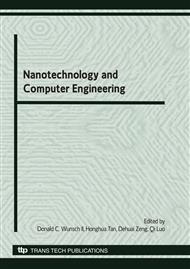[1]
M. Biehl, Success factors for implementing global information systems, Communications of the ACM, vol. 50(2007), pp.52-58.
DOI: 10.1145/1188913.1188917
Google Scholar
[2]
K.M. Rosacker and D.L. Olson, Public sector information system critical success factors, Transforming Government: People, Process and Policy, vol. 2 (2008), pp.60-70.
DOI: 10.1108/17506160810862955
Google Scholar
[3]
C. -Y. Huang, The relationship between information technology and firm performance in selected industries, Doctoral Dissertation, Nova Southeastern University, (2003).
Google Scholar
[4]
M. Huang and K. Xie, First-line and middle manager IT usage intention: A test of TAM, IEEE Computer Society (2008), pp.260-263.
Google Scholar
[5]
J. Xiao, Research on IT application maturity and critical success factors in mainland enterprises, Doctoral Dissertation, San Yat- Sen University, (2007).
Google Scholar
[6]
T.P. Nguyen, Attitudes toward wireless networking security: An analysis of the relationships between individual behaviors and common practices, Doctoral Dissertation, Capella University, (2005).
Google Scholar
[7]
H. Akkermans and K. v. Helden, Vicious and virtuous cycles in ERP implementation: A case study of interrelations between critical success factors, European Journal of Information Systems, vol. 11 (2002), pp.35-46.
DOI: 10.1057/palgrave.ejis.3000418
Google Scholar
[8]
M. Huang and C. -S. Wong, The effects of the first-line and middle manager on the IT application maturity, World Academic Press(2010), pp.36-40.
Google Scholar
[9]
M. Huang, The effects of the first-line and middle manager competence and usage intention on the IT application maturity, Doctoral Dissertation, Sun Yat-sen University, (2009).
Google Scholar
[10]
G. Zaltman, R. Duncan and J. Holbeck, Innovations and organizations, New York: Wiley&Sons(1973).
Google Scholar
[11]
B.H. Boar, Redesigning the IT organization for the information age, Information Systems Management, vol. 15(1998), pp.23-30.
Google Scholar
[12]
J.C. Barahona and A. Pentland, Advice networks and local diffusion of technological innovations, Communities and Technologies 2007: Proceedings of the Third Communities and Technologies Conference. (2007).
DOI: 10.1007/978-1-84628-905-7_25
Google Scholar
[13]
M. Huang and K. Xie, An exploring research on the informatization competence of first-line and middle managers, Journal of Information, vol. 27 (2008), pp.93-95.
Google Scholar
[14]
F.F. -H. Nah and S. Delgado, Critical success factors for enterprise resource planning implementation and upgrade, Journal of Computer Information Systems, vol. 46(2006), pp.99-113.
DOI: 10.1080/08874417.2006.11645928
Google Scholar
[15]
R. L. Nolan, Thoughts about the fifth stage, Database, vol. 7(1975), pp.4-10.
Google Scholar
[16]
Y. Liu, The Role of the Key Users in the ERP Application, Computer World (2009), pp.1-4.
Google Scholar
[17]
D.J.V. David, Adaptive learning systems technology advisor: A model for business entrepreneurs to implement IT, Doctoral Dissertation, The City University of New York, (2004).
Google Scholar
[18]
L.M. Spencer and S.M. Spencer, Competence at work: Models for superior performance, New York: Wiley(1993).
Google Scholar


